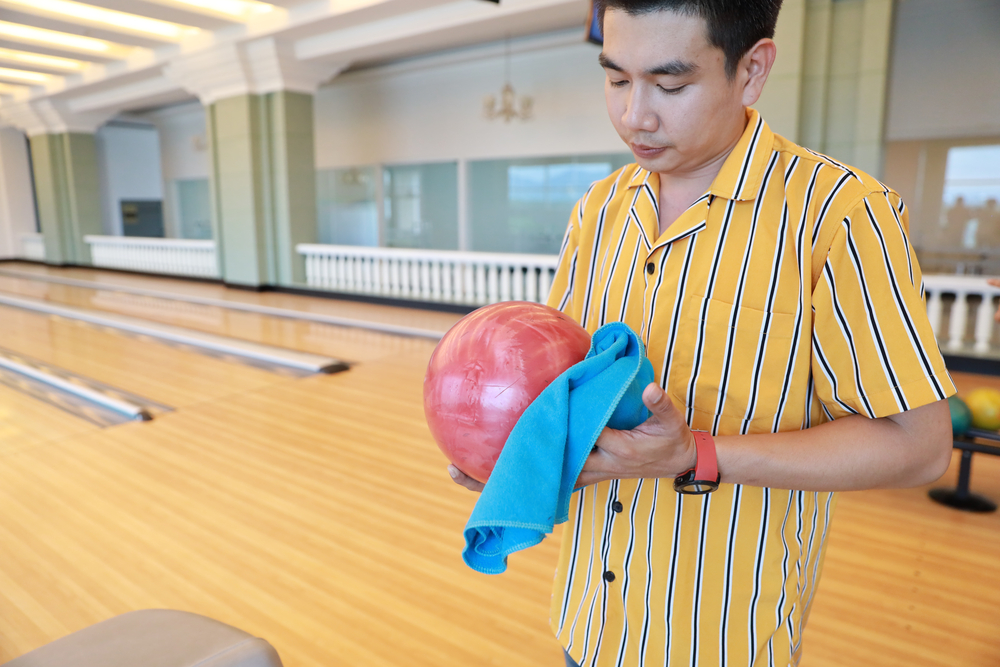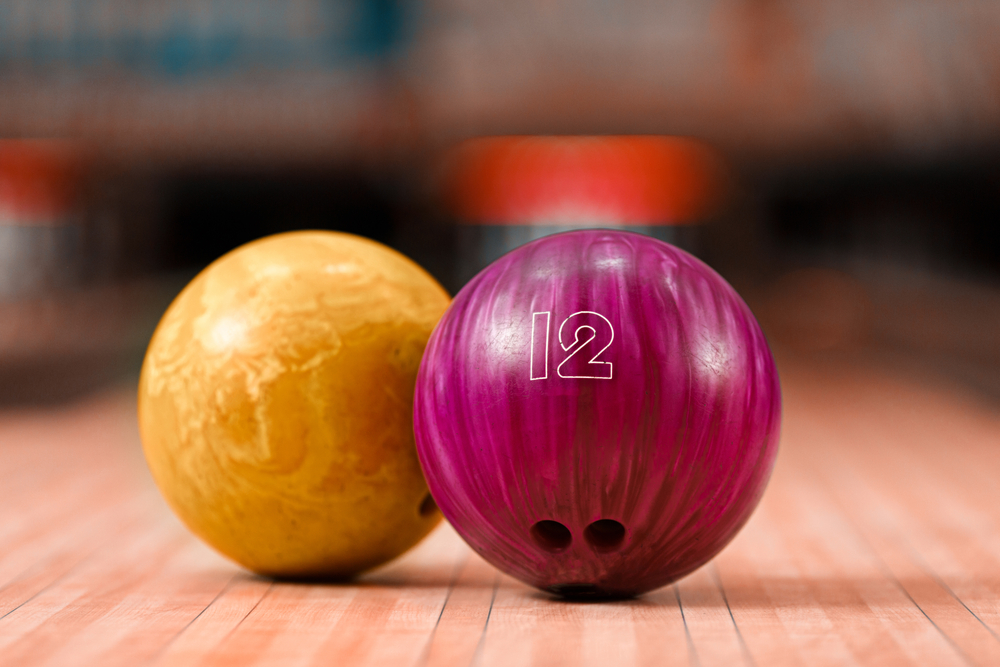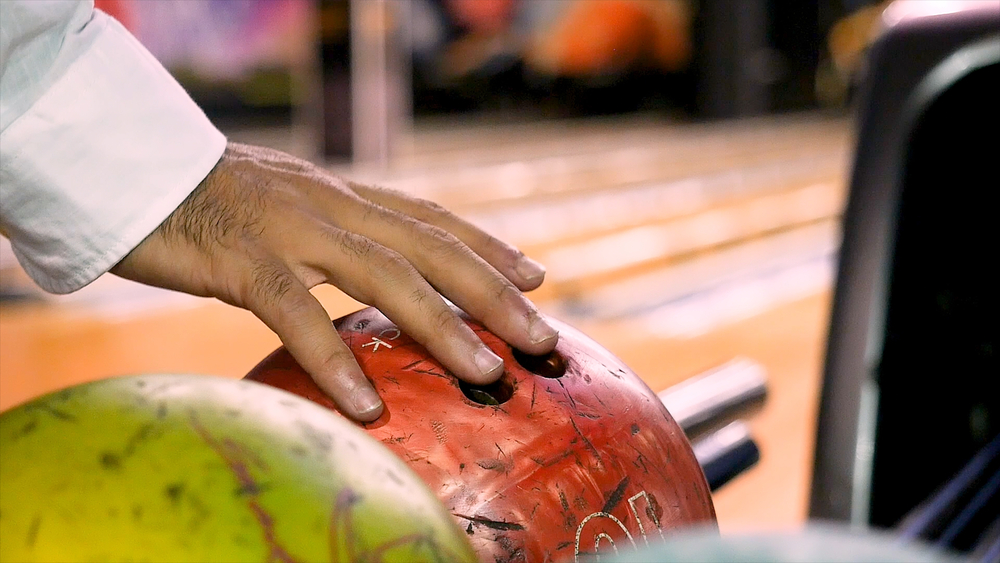
The sport of bowling revolves around three main pieces of equipment, a sixty-foot wooden lane, ten pins placed in a pyramid format and one bowling ball used to traverse the lane to (hopefully) knock down all ten pins.
As you enter the world of bowling it does not take you long to quickly realize that your bowling ball is the most important piece of your equipment and to maintain top performance bowling ball maintenance is important.
Now while some bowlers start off with using a house ball, the balls provided by a bowling alley, those that grow more committed to the sport will eventually purchase their own bowling ball.
While the initial purchase of a bowling ball can be expensive, having your own bowling ball comes with many different perks. You can choose a ball that fits your style of bowling best and then you can modify the ball to fit your needs exactly.
By selecting different internal components, types of coverstock and types of bowling ball surface calibrations a bowler is able to modify and adjust their ball to suit their specific way of bowling.
Naturally, with so much money and time being put into the bowling ball in order to adjust it to your specific needs, you are going to want to do everything you can to maintain your ball and keep it in top condition. This is where bowling ball maintenance becomes important.
This article will teach you everything we know about bowling ball maintenance, including all the different ways to clean and preserve your ball’s surface.
Contents
Why Is Bowling Ball Maintenance Important in the First Place?
As we mentioned earlier, one of the key pieces of equipment in the sport of bowling is a sixty-foot wooden lane. The lane acts at the surface the bowling ball must be hurtled down repeatedly as you take turns with your teammates knocking down pins.
Bowling balls are not light either and the friction generated from the repeated throws can slowly damage both the ball and the lane. To counteract this creation of friction bowling alleys began to lay down a type of oil onto the lane to ease the burn of friction and keep the lanes in peak condition. In addition, to keep the ball in peak condition, bowling ball surface maintenance is needed.
What no one counted on though was how the simple act of preserving the hard wooden lane would affect and change the game of bowling!
By using different oil patterns the sport of bowling discovered it could change a lane’s level of difficulty.
Soon machines came out that could be programmed to lay certain patterns and saturation down on the lanes and bowling ball coverstocks were made to adapt to the friction decreasing oil.
Nowadays, bowling balls come with coverstocks that have been worked over with different forms of grit.
These gritty makeovers (sanded bowling balls) result in microscopic pores that generate friction and increase ‘grab’ for hook throws.
However, as the bowling ball is used and thrown through oil pattern after oil pattern, the pores on the surface of the ball slowly become clogged with dirt and oil found on the lane and the ball can become scuffed and dented. Thus, the need to maintain your bowling ball.
When this occurs, the reaction of the ball slowly fades away and you are left with a ‘dead’ ball. This is where constant cleaning and maintenance comes in. By taking proper steps you can increase the life of your ball and keep it working the way you want it to.
Key Takeaways
- Bowling Ball Maintenance is Crucial: Regular cleaning and maintenance, which include using certified ball cleaners and maintaining the coverstock with sandpaper or polish, extend your ball's life and performance. Maintenance addresses lanes' friction and oil buildup, ensuring optimal reaction and grip.
- Understand Your Bowling Ball: The coverstock, which comprises a core, outer core (for two-piece balls), filler material, weight block, and coverstock, significantly influences your ball's lane behavior. Selecting the right coverstock material—sanded for more hook, polished for less—is vital.
- Coverstock Types Matter: Choose sanded and polished coverstocks based on the desired ball reaction. Sanded increases friction for more hook, while polished reduces it, allowing the ball to travel further before hooking. This choice affects maintenance methods and performance.
- Deep Cleaning Techniques: After extensive use, consider "baking" at a pro shop or a "bath" at home using hot water and dish soap to extract deep-seated oil and dirt. This prevents performance degradation and prepares the ball for resurfacing.
- Resurfacing Resets Performance: Done every 60 games or as needed, resurfacing rejuvenates your bowling ball's surface, restoring predictability and reaction. This can be professionally done or at home, but it's crucial for maintaining optimal ball condition and extending its lifespan.
Parts of a Bowling Ball
While there are many types of bowling balls out there, bowlers tend to stick to two general forms of balls, the two-piece or the three-piece.
A two-piece is a bowling ball that is made up of a core, outer core and coverstock while a three-piece consists of filler material, a weight block, and a thinner coverstock.
While the inner parts of a bowling ball play a role in how the ball will react and respond to certain throws, the true powerhouse of a bowling ball is its coverstock.
Coverstocks come in an assortment of materials and these different types react in different ways on the lane based on how they are used.
What is important to understand though that while the inner mechanisms of a bowling ball help, the coverstock is actually responsible for sixty to eighty percent of the performance of the ball, so make sure you take extra care in what materials you pick out!
Types of Coverstock

While there is a wide assortment of materials a coverstock could be made out of there are usually only two types of coverstock surfaces that bowlers use, sanded and polished.
A sanded coverstock has a rougher surface sanded on to it to increase friction. By sanding the surface like this the ball will hook more towards the end of the oil pattern.
A polished coverstock, as you can imagine, does the exact opposite. By bowling with a polished surface you can expect to see a decrease in friction and a ball that will roll further down the lane before it hooks.
Knowing which type of coverstock surface works best for you can greatly improve your game but you must also know that the type of surface you bowl with also affects how you clean it.
How to Clean Your Bowling Ball
Being able to properly clean your bowling ball takes time, money and dedication. There is no surefire way of preserving your ball indefinitely but constant cleaning and care can increase its lifespan.
However, you need to be careful with the steps you take in cleaning it and make sure to research how your specific ball and coverstock needs to be cleaned, otherwise, you could end up ruining your ball.
Cleaners
Using a cleaning agent is one of the simplest and shortest ways you can keep your ball clean and healthy. There are many different companies with different cleaners out there. When purchasing a cleaner you want to look at two main factors of the cleaner.
The first is what kind of coverstock the cleaner is intended to work on. Since there are so many different types of coverstock and coverstock surfaces it stands to reason that there are many types of coverstock cleaner formulas out there.
A cleaner that is intended for a sanded surface coverstock is going to work different from a cleaner designed for a polished surface, so make sure you take the time to read the labels and see which agent will work best for your ball.
The second factor to check is if the cleaner has been cleared by the United States Bowling Congress (USBC) for legal use in a league.
Cleaners are typically applied to a bowling ball after each use, in fact, if you ever watch a professional league you’ll probably see glimpses of bowlers quickly cleaning and buffering their bowling balls between turns. This constant and quick cleaning prevents the absorption of oil from the lane affecting their game.
With such high stakes on the professional level, players don’t want to take that chance and are constantly working to clean their balls between turns.
This is where the USBC regulations come in. In order to be allowed the use of a cleaner between turns bowlers must follow the rules laid down by the USBC and use a certified cleaner for a certified number of uses. How many times you can clean your ball in a league can even be affected by the cleaner, so take care of picking one out!
How to Use a Cleaning Agent
Cleaners are very important in the maintenance of your bowling ball, in fact, you can even consider them the front line in your ball’s defense.
Cleaners can typically be found in squeeze or spray bottle and should be applied to your ball’s surface after every use. (Note: How many times a cleaner can be applied consecutively may vary on the cleaner though, so be sure to read your bottle’s directions carefully!)
If you don’t want to clean the ball after each use, make sure you at least clean it at the end of the night to prevent the ball from sweating or absorbing oil during storage.
Once you have applied the cleaner onto the ball’s surface you can work the cleaner in using a towel or simply wipe it off with the towel, that all depends on the cleaner.
While a cloth towel can work a microfiber towel works best due to its high absorption rate. Once you have finished for the night wipe the ball down one more time and store until the next use.
Polish/Scuff
As mentioned before there are two typical types of coverstock surfaces that are used in the game of bowling, sanded and polished.
While cleaners help prevent oil from clogging your ball’s pores the friction of rolling down the lane does slowly wear down your ball’s polish and sanding. In order to keep your ball performing the way you want it to it is important that you work to maintain your coverstock’s surface to the standard you want it.
In order to bring you sanded surface back to its original form, you can use sandpaper or grit disks to work the surface over to the roughness you want it. If you are unsure or not comfortable with sanding the first few times take your ball into a pro shop.
You may have to pay a small maintenance fee but watching an expert work on your ball can give you some needed pointers until you are confident enough to sand at home.
For a polished surface, you’ll want to purchase a bottle of polisher. Polish can actually come in different types as well, from types that give you a smooth, shiny surface to types with different grit levels that can be used to adapt your ball to medium or dry oil patterns.
Both types of surfaces, sanded or polished, should be reworked after ten or fifteen games, depending on the type of ball and the performance it gives.
| Maintenance Type | Purpose | When to Apply | Tools/Products Needed |
|---|---|---|---|
| Cleaning | Remove oil and dirt to prevent clogging of pores | After every game | Certified cleaner, microfiber towel |
| Sanding | Increase friction for more hook | Every 10-15 games, or as needed | Sanding pad, Abralon pads |
| Polishing | Reduce friction for longer travel before hooking | Every 10-15 games, or as needed | Polishing compound |
| Baking/Bathing | Deep clean to extract embedded oil and dirt | Every 30-40 games | Pro shop baking or hot water bath with dish soap |
| Resurfacing | Reset surface to original condition | Every 60 games, or when performance decreases | Professional service or home resurfacing kit |
Bake or Bath
After about thirty or forty games it is time to either bake your ball or give it a bath. Yes, you read that right! Even with constant cleaning and preservation of your ball oil, dirt, debris, and dust will eventually work its way into the ball’s pores.
Soon enough, you’ll notice a decline in your ball's performance that doesn’t go away with a good cleaning or surface maintenance. When this occurs you have two methods you can do to give your ball a bit of a deep clean; bake it or bathe it!
Bake
When you are ‘baking’ your bowling ball you are actually taking it to the pro shop. There they have a machine that bakes your ball at a constant, high temperature. This causes the oil to come seeping out of the clogged pores before it is wiped off by the machine.
What is important to know about this method is that it must be done at a pro shop! Do not, and we repeat, do NOT stick your bowling ball in a home oven! Your home oven does not have the capability of heating your entire ball perfectly at a constant temperature.
So by heating your ball in your home oven you run the risk of in fact warping or ruining your bowling ball. Just take your ball to the pro shop and pay the small baking fee, trust us, it is a lot less expensive than having to get a brand new ball!
Bath
The other method we mentioned is the bathing method and this can, in fact, be done at home! While similar to the baking method, the bathing method uses a bucket, really hot water, and Dawn dish soap. (You can also use some other dish detergent with degreasing properties, just make sure it’s gentle.)
When bathing your ball you want to submerge it in the buck of hot water and dish soap and let it rest in the bucket for no later than twenty minutes. (Do not go over this time limit, you run the risk of warping your ball if you do.)
After your time is up take out the bowling ball and wipe off the surface with a microfiber towel, getting the oil that has seeped out of the pores. Dump out the water and repeat the process, continuing the bath cycle until oil no longer rises to the top of the water’s surface.
Bowling Ball Resurfaced?

Once you have reached your sixtieth (60th) game it is time to resurface your bowling ball. To resurface your bowling ball is to essentially hit the ‘reset’ button on your ball by completely sanding down and recalibrating your ball’s surface.
Periodic resurfacing helps keep your ball ‘alive’ a lot longer but will eventually wear the surface of your ball down past the legal diameter for league play. Due to this, it should be done only at your sixtieth game or beyond, depending on how your ball is reacting.
Now you may be wondering why bother with resurfacing then if its just going to sand away your nice expensive bowling ball?
Trust us, resurfacing your ball can really change how your ball reacts. By resurfacing you are resetting the pores on your ball's surface and smoothing out the debris and dents that affect your ball’s roll.
This helps rejuvenate your ball and bring back those nice, smooth, predictable rolls you count on. Predictability is key in the world of bowling!
To resurface you have essentially two options. You can take your ball into a pro shop and pay a fee that normally ranges between ten to thirty dollars or you can resurface the ball yourself at home.
Both methods come with their own set of pros and cons but with the ease of getting home-based equipment for the procedure, many bowlers have been choosing to save a little money and resurface at home.
When you think about it your bowling ball takes a lot of damage as you repeatedly hurl it down a sixty-foot lane. That is okay though, its what it is designed for after all!
Related Articles
My Final Words
Maintaining your bowling ball with the proper techniques and tools, such as sanding pads and Abralon pads, and understanding the general rule of care is essential in keeping your ball in peak performance. Focusing on the track area and applying more pressure with a lower grit for increased friction and better oil absorption ensures your ball stays in the best shape for your game.
Accepting that your bowling ball requires this level of attention grants you the ability to tailor its performance to your needs, giving it the major credit it deserves in your arsenal of bowling equipment. Remember, maintaining your bowling ball is about preserving its physical appearance and optimizing its interaction with the lanes for that perfect strike.
Kira Byrd, a Certified Fraud Examiner, holds a B.S. in Accounting from the University of Alabama at Birmingham. With a passion for bowling from her childhood, Kira has poured her expertise and personal experiences into creating and nurturing Bowling For Beginners. Kira's mission is to meet new bowlers where they are and guide them toward consistently achieving higher scores. With a focus on skill development and strategic techniques, she empowers readers to take control of their game and unlock their true potential.
Bowling For Beginners embodies strict editorial integrity, ensuring reliable and unbiased information. Kira's commitment to delivering valuable insights and practical strategies is reflected in every article. Here's an explanation of our editorial policy and how we get money.





